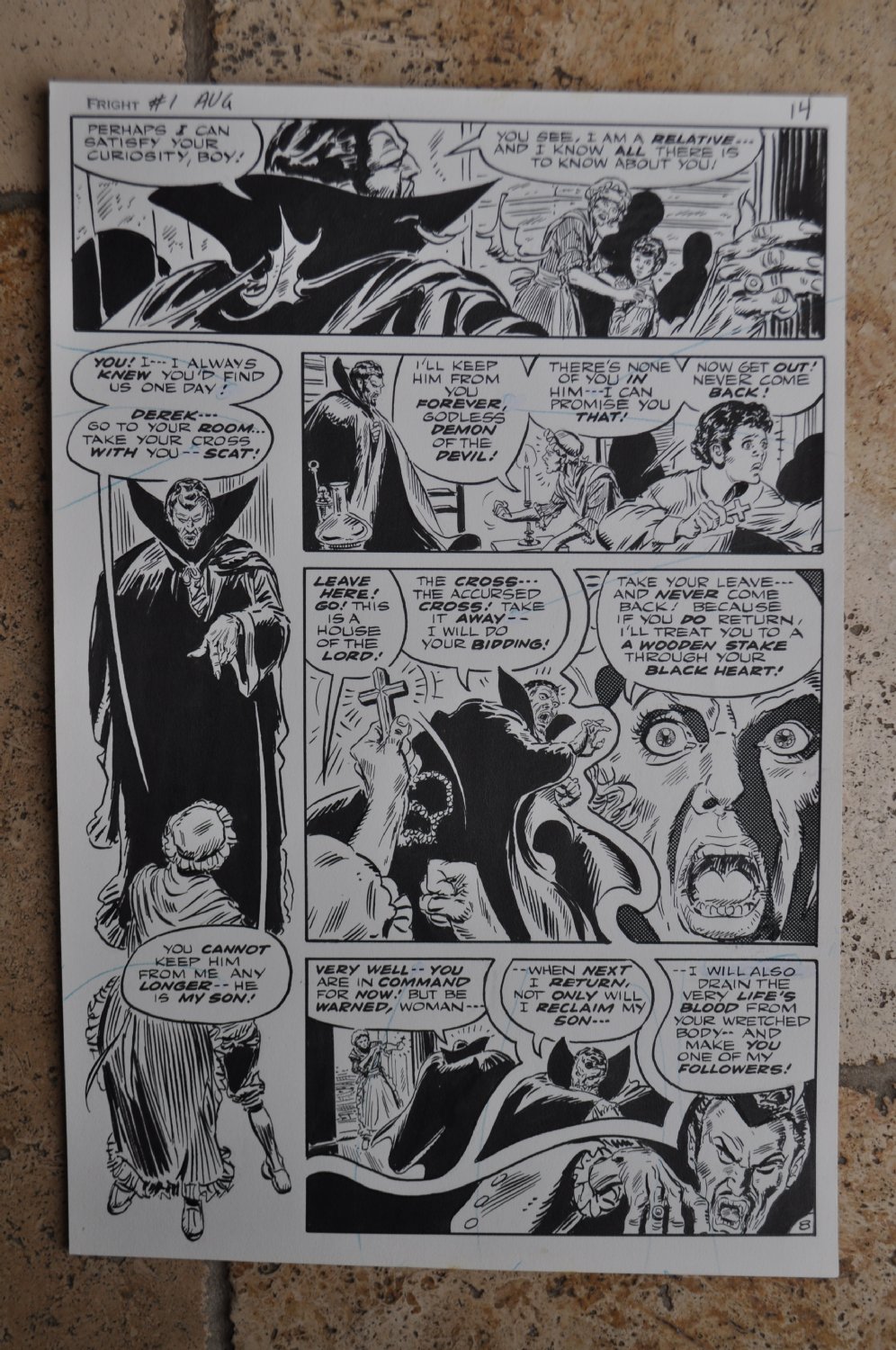Personal Collection // Frank Thorne // Fright: Son of Dracula Story (Frank Thorne) (1975)
| Title: | Fright: Son of Dracula Story (Frank Thorne) (1975) |
| Artists: |
Frank Thorne all
|
| Issue: | 01 |
| Page: | 08 |
| Media Type: | Pencil and Ink |
| Art Type: | Interior Page |
| Status: | Personal Collection |
| Views: | 1586 |
June 1975, Atlas/Seaboard, Fright: Son of Dracula #1, Page #8, Frank Thorne pencils/inks, “And Unto Dracula Was Born a Son!”, the complete 18 page story of the One-Shot issue of Son of Dracula #1, drawn by the incredible Frank Thorne, and written by Gary Friedrich, was published by the short-lived Atlas/Seaboard company founded by Martin Goodman. This story features the Son of Dracula in this lone issue. It tells of the original Dracula's union with a female blood relative. Betrayed by Dracula following the birth of their son, the unnamed woman sends the baby to America with a foster mother, with instructions for his "protection". Furious, Dracula vows to one day reclaim his son. Years later, in 1975, Columbia University professor Adam Lucard is horrified when his true nature reveals itself for the first time. Aware of his heritage, Lucard always takes nocturnal precautions passed down from his natural mother... but an intruder disturbs his rest and becomes his first victim. A bit of history for the younger fellas: Martin Goodman was pissed. The founder of Marvel Comics, recently retired from magazine publishing and fat with cash from the 1970 sale of the "House of Ideas" to Cadence Industries for millions of dollars, wanted to exact revenge from the new owners for their reneging on a promise to keep Martin's son, Charles "Chip" Goodman, installed as Marvel's editorial director. The comic book mogul's solution? Go head-to-head with the publisher of Spider-Man, etc, and initiate all-out war in the comic book marketplace-raiding the Big Two's talent pool; He lured the top creators of Marvel and DC with promises of higher page rates, return of original artwork, and sharing character ownership; Some of these artists were Neal Adams, Howard Chaykin, Alex Toth, Steve Ditko, Rich Buckler, John Severin, Michael Fleisher, Russ Heath, Wally Wood, Walter Simonson, Frank Thorne, Larry Lieber and Mike Sekowsky. In the late Summer of 1974, the comics press eagerly anticipated the arrival of the upstart Atlas/Seaboard (a moniker settled on by comic book historians to distinguish it from the 1950s line of Martin Goodman, though officially it was Seaboard Periodicals, parent company of the new Atlas Comics). Inside Comics #3 (Fall 1974) speculated, "Seaboard seems to be off on the right foot and, if their plans succeed, we may be in store for a real treat." Jim Steranko's Mediascene #11 (Jan.-Feb. 1975) crowed, "Seaboard Periodicals has unleashed a tidal wave of events on the stunned comics industry. Quicker than you can say, 'Jack the giant killer,' the new publishing company... is establishing itself as a leading contender in the race for comics supremacy." The Comic Reader #109 (Aug. 1974) gushed, "Goodman will undoubtedly use his contacts with distributors to Seaboard's advantage, so this looks like a comics group that will make it, and big... We know that the line-up will be exciting as well as surprising...." Such was the hyperbole generated throughout the industry concerning the arrival of Seaboard Periodicals in 1974. Yet, sadly, by mid-1975, after only ten months of publishing 65 color comics, six b&w comic mags and five text periodicals, Atlas/Seaboard would be no more.
Personal Collection





